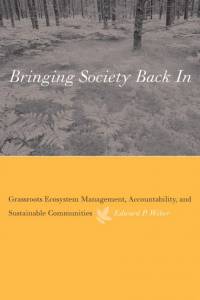
2003 | 334 Pages | ISBN: 0-262-23226-X | pdf | 1.44 Mb
Some of the most bitter controversies over U.S. environmental policies have occurred in small Western communities where timber, mining, and ranching interests have clashed with those seeking to preserve public lands for ecological or recreational purposes. Whether the conflict was over implementation of the Endangered Species Act, the National Forest Management Act, or any number of other federal or state laws, the out-come often was policy stalemate and local economic stagnation. At the national level, the experience in these cases stimulated ideological debates
over the relative importance of economic development and environmental protection, and fed an antienvironmental movement that sought to weaken federal statutes thought to contribute to these conflicts.
Against that background, one of the most intriguing developments of the past decade has been the rise of grassroots governance efforts in such Western communities, and elsewhere around the nation. Those directing these efforts have sought to reconcile competing values through collaborative and participatory decision making that brings together citizens, key stakeholder groups, and government agencies in a search for acceptable solutions. These ad hoc and voluntary processes have helped to foster consensus on habitat conservation plans for protecting endangered spe-
cies, restoration efforts for degraded ecosystems, smart-growth strategies for suburban communities, and redevelopment of contaminated lands.
These experiments highlight the importance of inquiry into how such grassroots environmental decision making actually works, how well it meets expectations for political accountability, how successful it is in achieving desired environmental outcomes, and the conditions that contribute to its success over time. |

 Auggie & Me gives readers a special look at Auggie’s world through three new points of view. Previously only available in ebook, now they’ll be published all together--complete with an introduction from the author on how she came to write them--in a gorgeous hardcover package!
Auggie & Me gives readers a special look at Auggie’s world through three new points of view. Previously only available in ebook, now they’ll be published all together--complete with an introduction from the author on how she came to write them--in a gorgeous hardcover package!  Living with Debt focuses on how to manage sovereign debt safely and effectively. The report traces the history of sovereign borrowing in Latin America, releases a new data set on public debt, and analyzes the evolution of debt, highlighting the recent trend toward higher levels of domestic debt and lower external borrowing. The report also includes a detailed study of the costs of sovereign defaults such as those that have affected some Latin American countries in recent years....
Living with Debt focuses on how to manage sovereign debt safely and effectively. The report traces the history of sovereign borrowing in Latin America, releases a new data set on public debt, and analyzes the evolution of debt, highlighting the recent trend toward higher levels of domestic debt and lower external borrowing. The report also includes a detailed study of the costs of sovereign defaults such as those that have affected some Latin American countries in recent years....  The 11th Edition of Fundamentals of Human Resource Management helps students understand and remember concepts through a straightforward and conversational writing style and a wealth of examples to clarify ideas and build interest. The authors provide a strong foundation of essential elements of Human Resource Management as well as a clear understanding of how Human Resource Management links with business strategy. Through practical applications, the authors illustrate the importance of employees...
The 11th Edition of Fundamentals of Human Resource Management helps students understand and remember concepts through a straightforward and conversational writing style and a wealth of examples to clarify ideas and build interest. The authors provide a strong foundation of essential elements of Human Resource Management as well as a clear understanding of how Human Resource Management links with business strategy. Through practical applications, the authors illustrate the importance of employees...  This book provides support to academics as well as managers, who deal with policies and strategies related to work issues. Effective work practices and good employee relations are a real necessity of nowadays organizations, as they can help to reduce absenteeism, employee turnover and organizational costs. Instead, they support high levels of commitment, effectiveness, performance as well as productivity. The book focusses on the implications of those changes in productivity and organizations ma...
This book provides support to academics as well as managers, who deal with policies and strategies related to work issues. Effective work practices and good employee relations are a real necessity of nowadays organizations, as they can help to reduce absenteeism, employee turnover and organizational costs. Instead, they support high levels of commitment, effectiveness, performance as well as productivity. The book focusses on the implications of those changes in productivity and organizations ma...  This book presents a practical and realistic approach to the study of human resource management. Concentrating on a common theme - the interrelationships among human resource management functions - the new edition features increased emphasis on multinational issues, a new section on total quality management and new coverage of how organizations respond to external environments....
This book presents a practical and realistic approach to the study of human resource management. Concentrating on a common theme - the interrelationships among human resource management functions - the new edition features increased emphasis on multinational issues, a new section on total quality management and new coverage of how organizations respond to external environments....